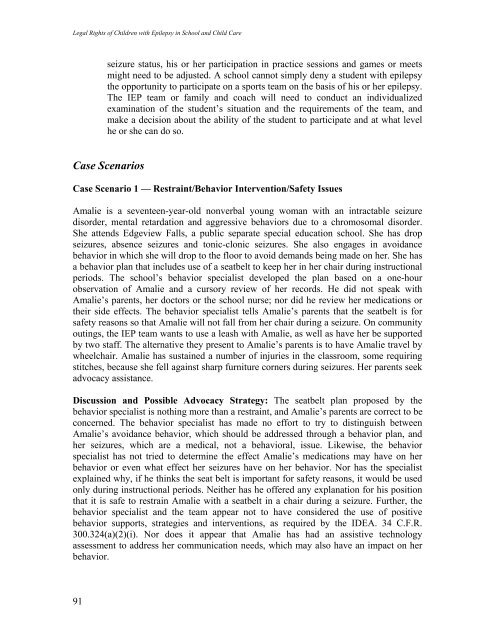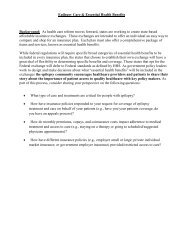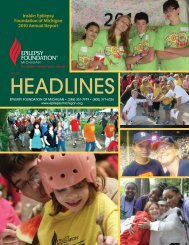Legal Rights of Children with Epilepsy in School & Child Care
Legal Rights of Children with Epilepsy in School & Child Care
Legal Rights of Children with Epilepsy in School & Child Care
Create successful ePaper yourself
Turn your PDF publications into a flip-book with our unique Google optimized e-Paper software.
<strong>Legal</strong> <strong>Rights</strong> <strong>of</strong> <strong><strong>Child</strong>ren</strong> <strong>with</strong> <strong>Epilepsy</strong> <strong>in</strong> <strong>School</strong> and <strong>Child</strong> <strong>Care</strong><br />
seizure status, his or her participation <strong>in</strong> practice sessions and games or meets<br />
might need to be adjusted. A school cannot simply deny a student <strong>with</strong> epilepsy<br />
the opportunity to participate on a sports team on the basis <strong>of</strong> his or her epilepsy.<br />
The IEP team or family and coach will need to conduct an <strong>in</strong>dividualized<br />
exam<strong>in</strong>ation <strong>of</strong> the student’s situation and the requirements <strong>of</strong> the team, and<br />
make a decision about the ability <strong>of</strong> the student to participate and at what level<br />
he or she can do so.<br />
Case Scenarios<br />
Case Scenario 1 — Restra<strong>in</strong>t/Behavior Intervention/Safety Issues<br />
Amalie is a seventeen-year-old nonverbal young woman <strong>with</strong> an <strong>in</strong>tractable seizure<br />
disorder, mental retardation and aggressive behaviors due to a chromosomal disorder.<br />
She attends Edgeview Falls, a public separate special education school. She has drop<br />
seizures, absence seizures and tonic-clonic seizures. She also engages <strong>in</strong> avoidance<br />
behavior <strong>in</strong> which she will drop to the floor to avoid demands be<strong>in</strong>g made on her. She has<br />
a behavior plan that <strong>in</strong>cludes use <strong>of</strong> a seatbelt to keep her <strong>in</strong> her chair dur<strong>in</strong>g <strong>in</strong>structional<br />
periods. The school’s behavior specialist developed the plan based on a one-hour<br />
observation <strong>of</strong> Amalie and a cursory review <strong>of</strong> her records. He did not speak <strong>with</strong><br />
Amalie’s parents, her doctors or the school nurse; nor did he review her medications or<br />
their side effects. The behavior specialist tells Amalie’s parents that the seatbelt is for<br />
safety reasons so that Amalie will not fall from her chair dur<strong>in</strong>g a seizure. On community<br />
out<strong>in</strong>gs, the IEP team wants to use a leash <strong>with</strong> Amalie, as well as have her be supported<br />
by two staff. The alternative they present to Amalie’s parents is to have Amalie travel by<br />
wheelchair. Amalie has susta<strong>in</strong>ed a number <strong>of</strong> <strong>in</strong>juries <strong>in</strong> the classroom, some requir<strong>in</strong>g<br />
stitches, because she fell aga<strong>in</strong>st sharp furniture corners dur<strong>in</strong>g seizures. Her parents seek<br />
advocacy assistance.<br />
Discussion and Possible Advocacy Strategy: The seatbelt plan proposed by the<br />
behavior specialist is noth<strong>in</strong>g more than a restra<strong>in</strong>t, and Amalie’s parents are correct to be<br />
concerned. The behavior specialist has made no effort to try to dist<strong>in</strong>guish between<br />
Amalie’s avoidance behavior, which should be addressed through a behavior plan, and<br />
her seizures, which are a medical, not a behavioral, issue. Likewise, the behavior<br />
specialist has not tried to determ<strong>in</strong>e the effect Amalie’s medications may have on her<br />
behavior or even what effect her seizures have on her behavior. Nor has the specialist<br />
expla<strong>in</strong>ed why, if he th<strong>in</strong>ks the seat belt is important for safety reasons, it would be used<br />
only dur<strong>in</strong>g <strong>in</strong>structional periods. Neither has he <strong>of</strong>fered any explanation for his position<br />
that it is safe to restra<strong>in</strong> Amalie <strong>with</strong> a seatbelt <strong>in</strong> a chair dur<strong>in</strong>g a seizure. Further, the<br />
behavior specialist and the team appear not to have considered the use <strong>of</strong> positive<br />
behavior supports, strategies and <strong>in</strong>terventions, as required by the IDEA. 34 C.F.R.<br />
300.324(a)(2)(i). Nor does it appear that Amalie has had an assistive technology<br />
assessment to address her communication needs, which may also have an impact on her<br />
behavior.<br />
91








